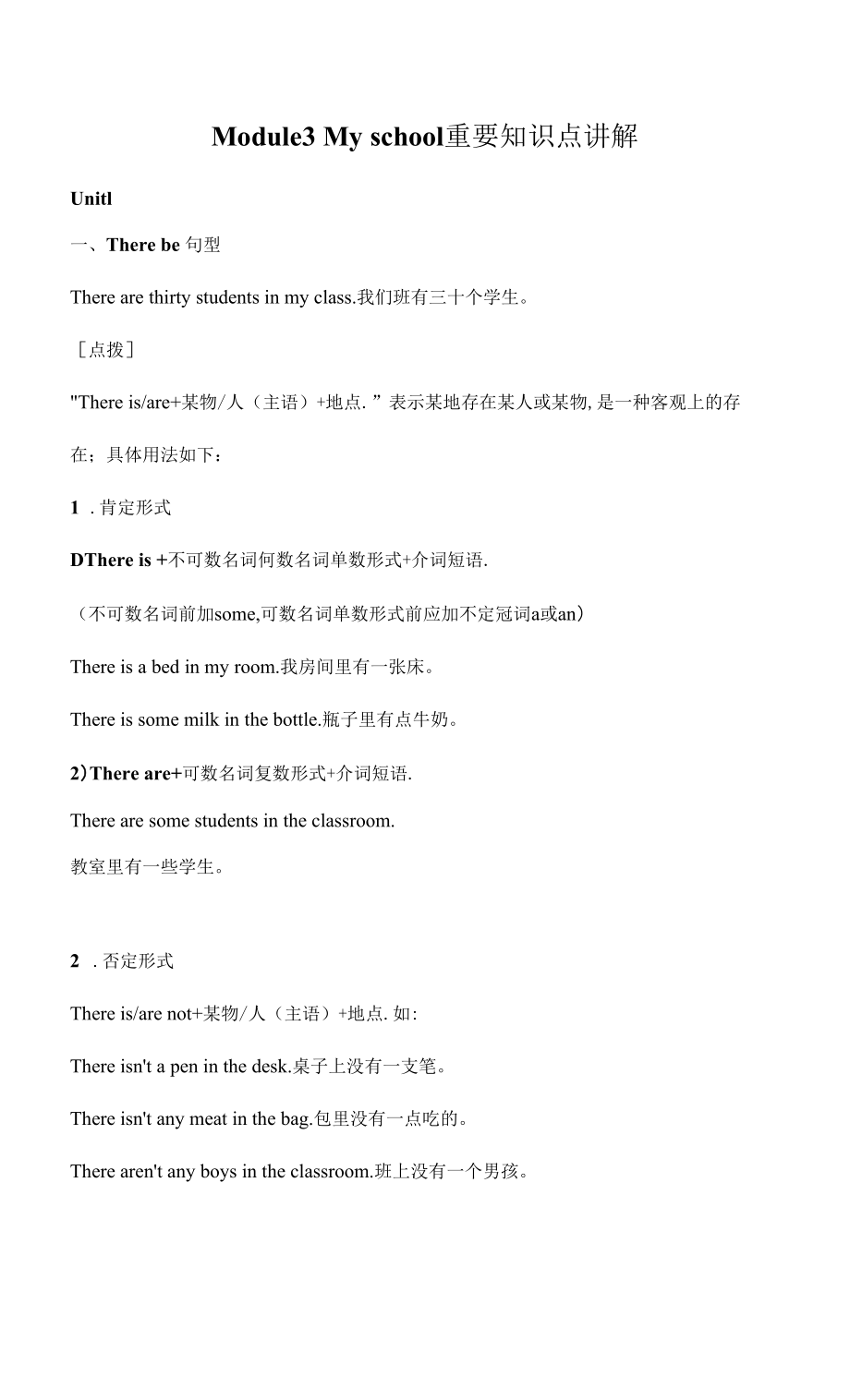《外研版七年級(jí)上冊(cè)英語Module 3 My school 重要知識(shí)點(diǎn)講解》由會(huì)員分享�,可在線閱讀,更多相關(guān)《外研版七年級(jí)上冊(cè)英語Module 3 My school 重要知識(shí)點(diǎn)講解(6頁珍藏版)》請(qǐng)?jiān)谘b配圖網(wǎng)上搜索�。
1、Module3 My school重要知識(shí)點(diǎn)講解
Unitl
一�、There be 句型
There are thirty students in my class.我們班有三十個(gè)學(xué)生�����。
[點(diǎn)撥]
"There is/are+某物/人(主語)+地點(diǎn).”表示某地存在某人或某物,是一種客觀上的存
在����;具體用法如下:
1 .肯定形式
DThere is +不可數(shù)名詞何數(shù)名詞單數(shù)形式+介詞短語.
(不可數(shù)名詞前加some,可數(shù)名詞單數(shù)形式前應(yīng)加不定冠詞a或an)
There is a bed in my room.我房間里有一張床�。
There is some milk in t
2、he bottle.瓶子里有點(diǎn)牛奶�����。
2)There are+可數(shù)名詞復(fù)數(shù)形式+介詞短語.
There are some students in the classroom.
教室里有一些學(xué)生�����。
2 .否定形式
There is/are not+某物/人(主語)+地點(diǎn).如:
There isn't a pen in the desk.桌子上沒有一支筆���。
There isn't any meat in the bag.包里沒有一點(diǎn)吃的�。
There aren't any boys in the classroom.班上沒有一個(gè)男孩���。�
3 .一般疑問句形式
-Be+there
3�、+(any)+某物+地點(diǎn)����?
-Yes, there be./No, there be+not.
如:
-Is there any milk in the bottle?瓶子里有牛奶嗎���?
-Yes, there is.有。
-Are there any girls in the classroom?班上有女生嗎�����?
-No, there aren't.沒有�。
4 .特殊疑問句形式
疑問詞+一般疑問句?如:
-How many books are there on the desk?桌上有幾本書����?
-There is only one book on the desk.桌上只有一
4、本書���。
5.當(dāng)there be句型接多個(gè)主語時(shí),它要求用就近原則���;
即如果靠近be動(dòng)詞的名詞為單數(shù)��,則be用is,如果靠近be動(dòng)詞的名詞為復(fù)數(shù),
則be動(dòng)詞用are����。
There is a pen and two pencils on the desk.
桌上有一支鋼筆和兩支鉛筆。
There are two pencils and a pen on the desk.
桌山有兩支鉛筆和一支鋼筆���。
二���、some與any的用法
[點(diǎn)撥]�
Lsome用在肯定句中;some+不可數(shù)名詞或可數(shù)名詞的復(fù)數(shù)
There is some rice in the bottle.
Th
5����、ere are some bananas on the tree.
2.any用在否定句中/疑問句中;any+不可數(shù)名詞或可數(shù)名詞的復(fù)數(shù)
There aren't any coats under the bed.床下沒有衣服��。
Is there any milk in the c叩?杯子里有牛奶嗎�?
Are there any cakes on the table?桌上有蛋糕嗎?
Unit 2
一�����、 常有介詞短語
[點(diǎn)撥]
behind在…之后
next to在...旁邊
in front of 在…前面
on the right of在…右邊
on the left
6�、of在…左邊
between.. .and...在…和…之間
in the middle of 在…中間
二、 詢問某地的位置
-Where is the playground?操場(chǎng)在哪���?
-It's behind the classroom building.在教學(xué)樓的后面����。
[點(diǎn)撥]
“Where is+某地?”用于詢問某地的位置。�
回答可用前面提及的介詞短語����。
Unit 3
一、There be句型與have的比較
[點(diǎn)撥]
there be句型表示“某處有某物"���,即存在關(guān)系;如:
There is a pen on the desk.桌上有一支筆����。
動(dòng)詞h
7���、ave或has也表示“有”的意思��,但have (has)表示所屬關(guān)系�,經(jīng)常用“人”作主
語�����,表達(dá)“某人有...”����;如:
I have a pen.我有一支筆。
二���、in front of 和 in the front of 區(qū)別
[點(diǎn)撥]
in front of在...(范圍外)前面
There is a house in front of the river.
在小河的前面有一座房子����。
in the front of在...(范圍內(nèi))的前面
There is a blackboard in the front of the classroom.
在教室的前面有一塊黑板�。
8、
三���、after和behind區(qū)別
[點(diǎn)撥]
1 .after表示時(shí)間����,表示在一點(diǎn)或一段時(shí)間之后;
在表示地點(diǎn)時(shí)���,它表示次序���,意為“在…后面”。
He goes to school after 6 o'clock.�
他六點(diǎn)鐘以后去學(xué)校�����。
We walk into the meeting room one after another.
我們依次進(jìn)入會(huì)議室�。
2.behind表示時(shí)間時(shí),指退于既定的時(shí)間;
表示地點(diǎn)時(shí)����,強(qiáng)調(diào)位置的后面。
The project is already a month behind with things.
這個(gè)項(xiàng)目已經(jīng)比預(yù)定進(jìn)度晚了一個(gè)月����。
The chair is behind the desk.
椅子在桌子后面。
 外研版七年級(jí)上冊(cè)英語Module 3 My school 重要知識(shí)點(diǎn)講解
外研版七年級(jí)上冊(cè)英語Module 3 My school 重要知識(shí)點(diǎn)講解

